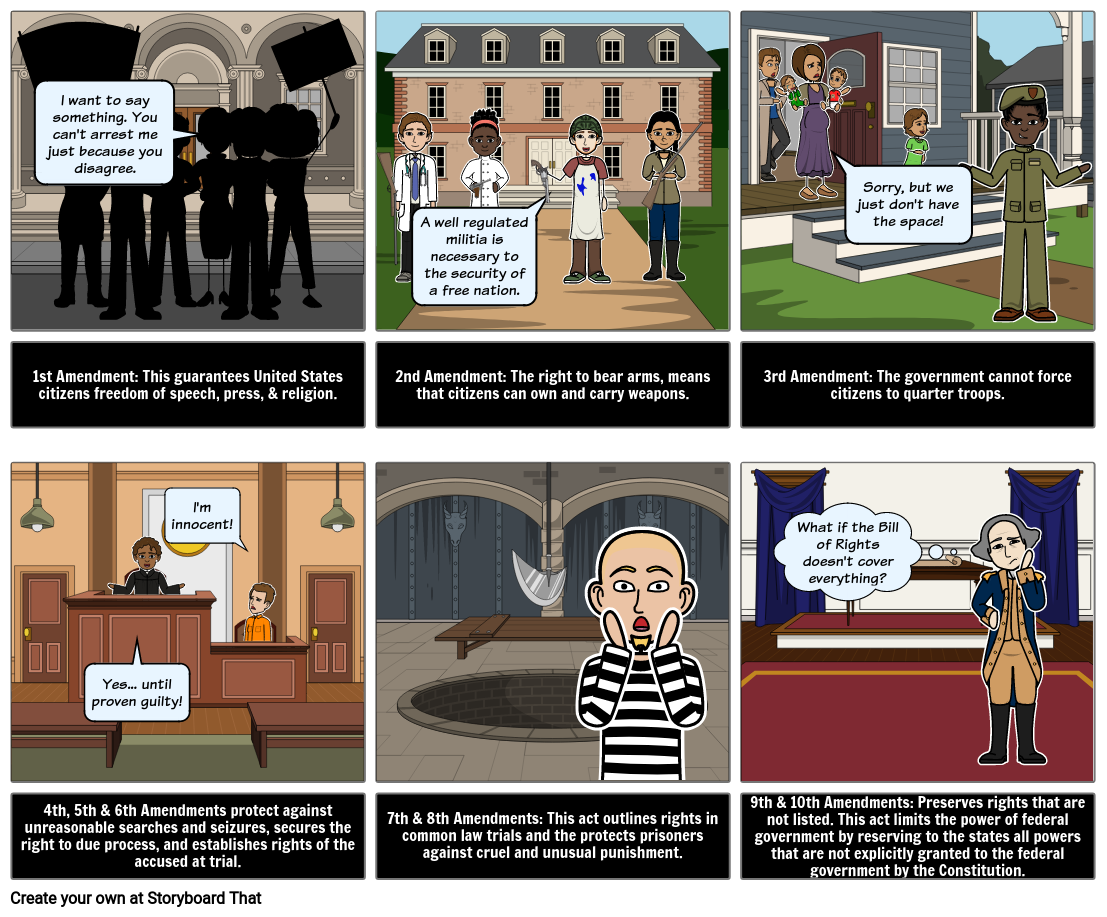https://www.storyboardthat.com/lesson-plans/bill-of-rights/10-amendments
Activity Overview
The most important document in U.S. history, besides the Declaration of Independence, was the Bill of Rights. After its ratification in 1787, the Bill of Rights secured many of the rights still central to American democracy. For this activity, have students research and visually depict the amendments contained in the Bill of Rights.
Bill of Rights Summary - The First Ten Amendments
| 1st Amendment | This amendment guarantees United States citizens the freedom of speech, press, & religion. |
|---|---|
| 2nd Amendment | The right to bear arms means that citizens can own and carry weapons. |
| 3rd Amendment | The government cannot force citizens to quarter troops. |
| 4th, 5th & 6th Amendments | These amendments protect against unreasonable searches and seizures, secures the right to due process, and establishes rights of the accused at trial. |
| 7 & 8th Amendments | These outline rights in common law trials and the protect prisoners against cruel and unusual punishment. |
| 9 & 10th Amendments | Rights that are not listed in the Constitution are preserved here. This act limits the power of federal government by reserving to the states all powers that are not explicitly granted to the federal government by the Constitution. |
Template and Class Instructions
(These instructions are completely customizable. After clicking "Copy Activity", update the instructions on the Edit Tab of the assignment.)
Student Instructions
Create a storyboard that depicts the first 10 Amendments of the Bill of Rights
- Click "Start Assignment".
- Write the amendment and a brief summary in the description boxes.
- Create illustrations that depict the descriptions using images and dialogue bubbles.
- Save and Exit
Lesson Plan Reference
Rubric
(You can also create your own on Quick Rubric.)
Rubric
| Proficient 5 Points | Emerging 3 Points | Beginning 1 Points | |
|---|---|---|---|
| Explanation | The descriptions are clear and at least two sentences. | The descriptions can be understood but it are somewhat unclear. | The descriptions are unclear and are not at least two sentences. |
| Illustrations | The illustrations represent the descriptions using appropriate scenes, characters and items. | The illustrations relate to the descriptions, but are difficult to understand. | The illustrations do not clearly relate to the descriptions. |
| Evidence of Effort | Work is well written and carefully thought out. | Work shows some evidence of effort. | Work shows little evidence of any effort. |
| Conventions | Spelling, grammar, and punctuation are mostly correct. | Spelling, grammar, and punctuation are somewhat correct. | Spelling, grammar, and punctuation are mostly incorrect. |
More Storyboard That Activities
Bill of Rights
This Activity is Part of Many Teacher Guides
*(This Will Start a 2-Week Free Trial - No Credit Card Needed)
https://www.storyboardthat.com/lesson-plans/bill-of-rights/10-amendments
© 2024 - Clever Prototypes, LLC - All rights reserved.
StoryboardThat is a trademark of Clever Prototypes, LLC, and Registered in U.S. Patent and Trademark Office
© 2024 - Clever Prototypes, LLC - All rights reserved.
StoryboardThat is a trademark of Clever Prototypes, LLC, and Registered in U.S. Patent and Trademark Office












